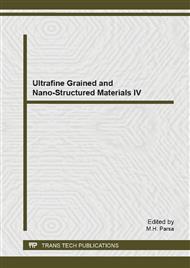[1]
M. Sarioglu, U. A. Atay, Y. Cebeci, Desalination 181 (2005) 303.
Google Scholar
[2]
H. Yong-Mei, C. Man, H. Zhong-Bo, J. Hazard. Mater. 184 (2010) 392.
Google Scholar
[3]
Y. Mido, M. Satake, Chemicals in the Environment, Discovery Publishing House, New Delhi, (1995).
Google Scholar
[4]
J.S. Espana, E.L. Pamo, E.S. Pastor, J.R. Andres, J.A.M. Rubi, The removal of dissolved metals by hydroxysulphate during oxidation and neutralization of acid mine waters, Aquat. Geochem. 12(2006) 269-298.
DOI: 10.1007/s10498-005-6246-7
Google Scholar
[5]
M.G. de Fonseca, M.M. de Olivera, L.N.H. Arakaki, J.G.P. Espinola, C. Airoldi, Nat-ural vermiculite as an exchanger support for heavy cations in aqueous solution, J. Colloid Interface Sci. 285(2005) 50-55.
DOI: 10.1016/j.jcis.2004.11.031
Google Scholar
[6]
O. Arous, A. Gherrous, H. Kerdjoudj, Removal of Ag(Ι), Cu(ΙΙ) and Zn(ΙΙ) ions with a supported liquid membrane containing cryptands as carriers, Desalination 161(2004) 295-303.
DOI: 10.1016/s0011-9164(03)00711-2
Google Scholar
[7]
U.B. Ogutveren, S. Koparal, E. Ozel, Electrodialysis for the removal of copper ions from wastewater, J. Environ. Sci. Health A 32(1997) 749-761.
Google Scholar
[8]
S.H. Hasan, P. Srivastava, Batch and countinuous biosorption of Cu2+ by immobilized biomass of Arthrobacter sp, J. Environ. Manage. 90(2009) 3313-3321.
DOI: 10.1016/j.jenvman.2009.05.005
Google Scholar
[9]
Y. Sag, Y. Aktay, Kinetic studies on sorption of Cr(ΙV) and Cu(ΙΙ) ions by chitin, chitosan and Rhizopus arrhizus, Biochem. Eng.J. 12(2002) 143-153.
DOI: 10.1016/s1369-703x(02)00068-2
Google Scholar
[10]
J.C. Zheng, H.M. Feng, M.H.W. Lam, P.K.S. Lam, Y.W. Ding, H.Q. Yu, Removal of Cu(ΙΙ) in aqueous media by biosorption using water hyacinth roots as a biosorbent material, J. Hazard. Mater. 177(2009) 780-785.
DOI: 10.1016/j.jhazmat.2009.06.078
Google Scholar
[11]
S.S. Banerjee R.V. Jayaram, M.V. Joshi, RemovL OF Cr(VΙ) and Hg(ΙΙ) from aqueous solutions using fly ash and impregnated fly ash, Sep. Sci. Technol. 39 (2004) 1611-1629.
DOI: 10.1081/ss-120030778
Google Scholar
[12]
S.M. Zhu, N. Yang, D. Zhang, Poly(N, N-dimethylaminoethyl metacrylate)modification of activated carbon for copper ions removal, Mater. Chem. Phys. 113(2009) 784-789.
DOI: 10.1016/j.matchemphys.2008.08.025
Google Scholar
[13]
G.P. Rao, C. Lu, F. Su, Sorption of divalent metal ions from aqueous solution by carbon nanotubes: a review, Sep. Purif. Technol. 58(2007) 224-231.
DOI: 10.1016/j.seppur.2006.12.006
Google Scholar
[14]
A.H. Chen, S.C. Liu, C.Y. Chen, Comparative adsorption of Cu(ΙΙ), Zn(ΙΙ), and Pb(ΙΙ) ions in aqueous solution on the crosslinked chitosan whit epichlorohydrin, J. Hazard. Mater. 154(2008) 184-191.
DOI: 10.1016/j.jhazmat.2007.10.009
Google Scholar
[15]
S.R. Shukla, V.G. Gaikar, R.S. Pai, U.S. Suryavanshi, Batch and column adsorption of Cu(ΙΙ) on unmodified and oxidized coir, Sep. Sci. Technol. 44(2009) 40-62.
DOI: 10.1080/01496390802281984
Google Scholar
[16]
P. Yin, Q. Xu, R.J. Qu, G.F. Zhao, Removal of transition metal ions from aqueous solutions by adsorption onto a novel silica gel matrix composite adsorbent, J. Hazard. Mater. 169(2009) 228-232.
DOI: 10.1016/j.jhazmat.2009.03.081
Google Scholar
[17]
M. Dogan, A. Turkylmaz, M. Alkan, O. Demirbas, Adsorption of copper(ΙΙ) ions onto sepiolite and electrokinetic properties, Desalination 238(2009) 257-270.
DOI: 10.1016/j.desal.2008.02.017
Google Scholar
[18]
M. Yavuz, F. Gode, E. Pehlivan, S. Ozmert, Y.C. Sharma, An economic removal of Cu2+ and Cr3+ on the new adsorbents: pumice and polyacrylonitrile/pumice composite, Chem. Eng. J. 137(2008) 453-461.
DOI: 10.1016/j.cej.2007.04.030
Google Scholar
[19]
R. Rangsivek, M.R. Jekel, Removal of dissolved metals by zero-valent iron(ZVI): Kinetics, equilibria, processes and implications for stormwater runoff treatment, Water Res. 39(2005) 4153-4163.
DOI: 10.1016/j.watres.2005.07.040
Google Scholar
[20]
L.C. Zhou, Y.F. Li, X. Bai, G.H. Zhao, Use of microorganisms immobilized on com posite polyurethane foam to remove Cu(ΙΙ) from aqueous solution, J. Hazard. Mater. 167(2009) 1106-1113.
DOI: 10.1016/j.jhazmat.2009.01.118
Google Scholar
[21]
D. Turkmem, E. Yilmaz, N. Ozturk, S. Akgol, A. Denizli, poly(hydroxyethylmethacrylate) nanobeads containing imidazole groups for removal of Cu(ΙΙ) ions, Mater. Sci. Eng. C 29 (2009) 2072-(2078).
DOI: 10.1016/j.msec.2009.04.005
Google Scholar
[22]
H. Parham, B. Zargar, R. Shiralipour, J. Hazard. Mater. 205-206 (2012) 94-100.
Google Scholar
[23]
J. J. Kim, S. K. Kim, J. U. Bae. Thin Solid Films 415 (2002) 101–107.
Google Scholar
[24]
J.H. Jang, H.B. Lim, J. Microchem. 94 (2010) 148–158.
Google Scholar
[25]
Standard methods for the examination of water and wastewater 20th edition-3500 Cu B-Neocoproine method.
Google Scholar


